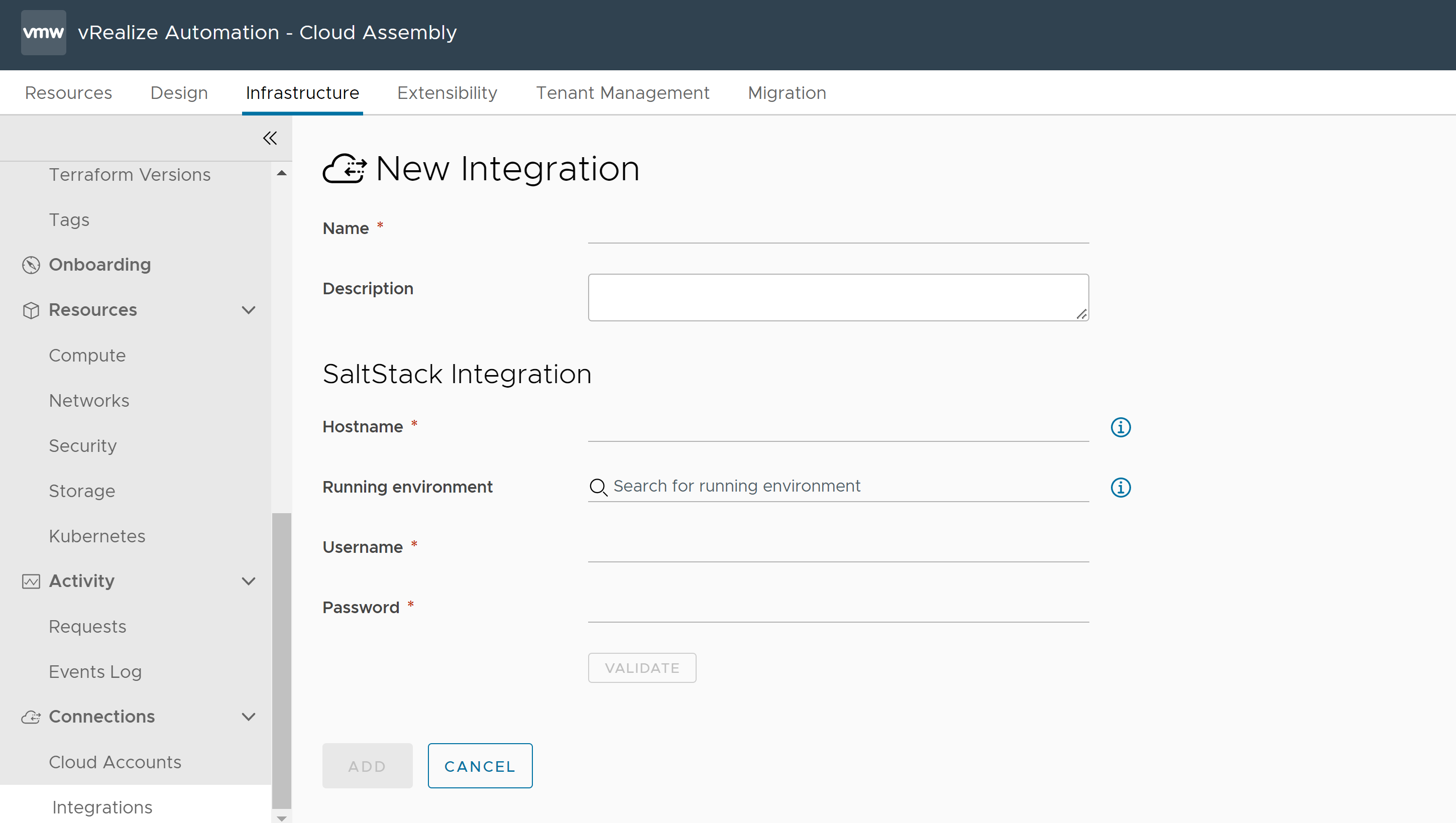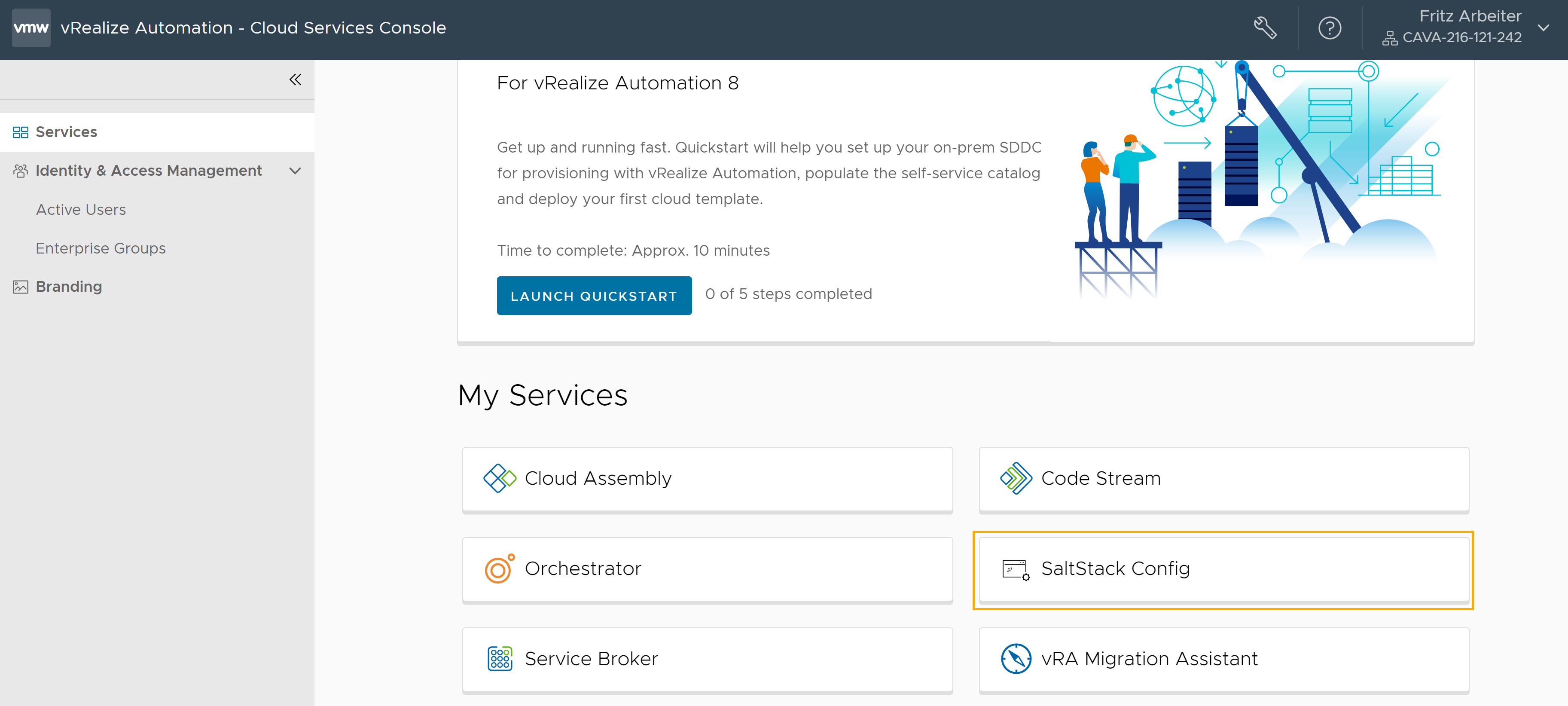You can configure a SaltStack Config integration to access the SaltStack Config service and use SaltStack Config objects and actions in vRealize Automation.
Installation
Before integrating SaltStack Config with vRealize Automation, you must first install it in your environment. See Installing and Configuring SaltStack Config for more information.
Considerations
Integrated SaltStack Config is available for vRealize Automation with the following conditions:
The SaltStack Config integration is associated to a specific host during install.
Only one SaltStack Config integration is available per organization.
The vRealize Automation tenant can only support one Salt master. The Salt master can support multiple minions.
-
Before you can delete a SaltStack Config integration in vRealize Automation, you must delete any existing deployments that use the SaltStack Config integration.
Prerequisites
Verify that you have vRealize Automation administrator credentials and SaltStack Config administrator credentials (root level access).
You need vRealize Automation administrator credentials and SaltStack Config administrator credentials (root level access) to create a SaltStack Config integration.
You also need SaltStack Config administrator credentials to open and work in the SaltStack Config service itself.
You use vRealize Automation credentials to access vRealize Automation and SaltStack Config credentials to access SaltStack Config.
For information about SaltStack Config administrator credentials, see the Installing and Configuring SaltStack Config guide.
Verify that the SaltStack Config service is installed.
Verify that the Salt master you are using with the SaltStack Config integration contains the Master Plugin.
- You must be subscribed to the SaltStack Config service.
Verify that you have the SaltStack Config service administrator role in vRealize Automation. See What are the vRealize Automation user roles
Verify that you have the Cloud Assembly service administrator role in vRealize Automation. See Organization and service user roles in vRealize Automation.
Configure a SaltStack Config integration in vRealize Automation
After you install SaltStack Config for vRealize Automation, you can configure the integration in Cloud Assembly.
- In Cloud Assembly, select , and click Add Integration.
- Select the SaltStack Config integration type.

- Complete the form.

- Enter a name for the integration.
- (Optional) Provide a description for the integration.
- Enter a hostname for the SaltStack Config server.
- Select the embedded-ABX-onprem running environment.
- Enter the SaltStack Config administrator user name and password used to access the specific host.
- Click Validate to confirm your administrator access to the SaltStack Config service.
If validation fails, make sure you entered the correct hostname, user name, and password.
- Click Save.
Access your SaltStack Config integration
After you save your changes to the SaltStack Config integration point, you can open the SaltStack Config service.
If you deployed SaltStack Config through vRealize Suite Lifecycle Manager, you can click the service tile from the vRealize Automation Service Console to open the integration and access the host.

If you did a stand-alone install of SaltStack Config, you can access the service using your SaltStack Config hostname.
- When prompted to log in to SaltStack Config, enter your SaltStack Config administrator user name and password.
If you need to make any changes to the integration, select , select the available SaltStack Config integration tile, and click Open.
The hostname cannot be changed after you configure the integration. You can only edit the name, description, running environment, and credentials for the integration.
What's next
SaltStack Config is a stand-alone product that you can integrate with and use in vRealize Automation.
Learn how to add the SaltStack Config resource to install minions on virtual machines in your Cloud Assembly deployments.